Intel Ghost Canyon NUC9i9QNX Review: NUC 9 Extreme Realizes the SFF Dream
by Ganesh T S on April 16, 2020 8:05 AM ESTGPU Performance - Gaming Workloads
The gaming test suite for SFF PCs was revamped in mid-2018 with six different games:
- Civlization VI (DX12)
- Dota 2
- F1 2017
- Grand Theft Auto V
- Middle Earth: Shadow of War
- Far Cry 5
Most system reviews take a handful of games and process them at one resolution / quality settings for comparison purposes. Recently, we have seen many pre-built systems coming out with varying gaming capabilities. Hence, it has become imperative to give consumers an idea of how a given system performs over a range of resolutions and quality settings for each game. Our test suite is able to address this aspect.
Civilization VI (DX12)
The Civilization series of turn-based strategy games is very popular. For such games, the frame rate is not necessarily an important factor in the gaming experience. However, with Civilization VI, Firaxis has cranked up the visual fidelity to make the game more attractive. As a result, the game can be taxing on the GPU as well as the CPU, particularly in the DirectX 12 mode.
| Civilization VI (DirectX 12) Performance | |||
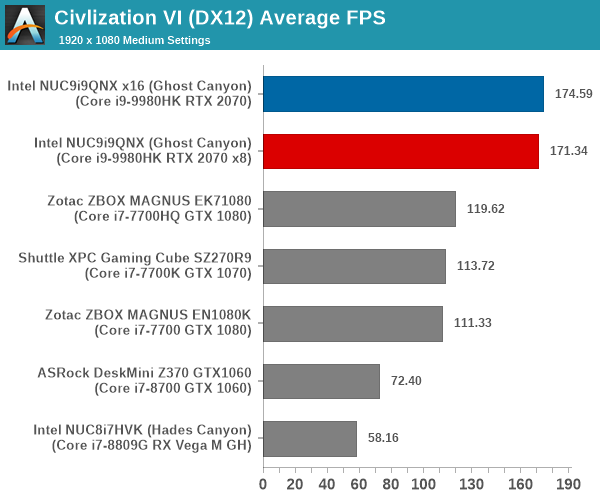
We processed the built-in benchmark at two different resolutions (1080p and 2160p), and with two different quality settings (medium and ultra, with the exact differences detailed here). There are no surprises here, with the RTX 2070 performing way better than the previous-generation GPUs. Operating the RTX 2070 in x16 mode results in slightly better performance (around 3 - 4 fps better, but very much dependent on the quality and resolution) compared to a x8 configuration
Dota 2
Dota 2 has been featuring in our mini-PC and notebook reviews for a few years now, but, it still continues to be a very relevant game. Our evaluation was limited to a custom replay file at 1080p resolution with enthusiast settings ('best-looking' preset). We have now revamped our testing to include multiple resolutions - This brings out the fact that the game is CPU-limited in many configurations.
Dota 2 allows for multiple renderers - we use the DirectX 11 mode. The rendering settings are set to 'enthusiast level' (best-looking, which has all options turned on, and at Ultra level, except for the Shadow Quality set to 'High'). We cycle through different resolutions after setting the monitor resolution to match the desired resolution. The core scripts and replay files are sourced from Jonathan Liebig's original Dota 2 benchmarking instructions which used a sequence of frames from Match 3061101068.
| Dota 2 - Enthusiast Quality Performance | |||
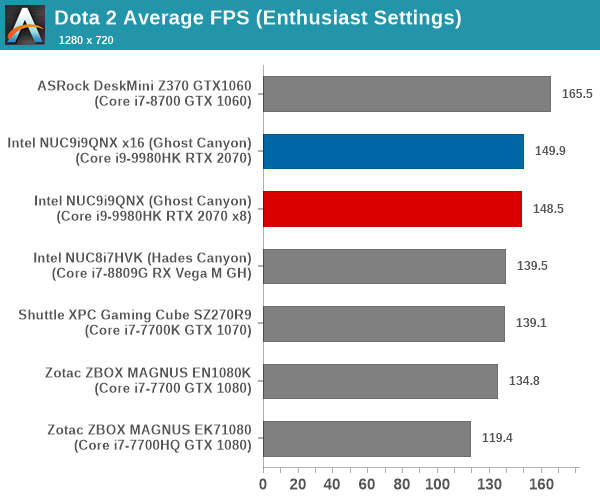
Due to the CPU-limited nature of the game, the Ghost Canyon NUC is not able to emerge as a clear winner here. However, the performance is more than enough to provide an excellent experience across all resolutions and quality settings for Dota 2.
F1 2017
Our gaming system reviews have always had a representative racing game in it. While our previous benchmark suite for PCs featured Dirt 2, we have moved on to the more recent F1 2017 from Codemasters for our revamp.
| F1 2017 - Ultra Quality Performance | |||
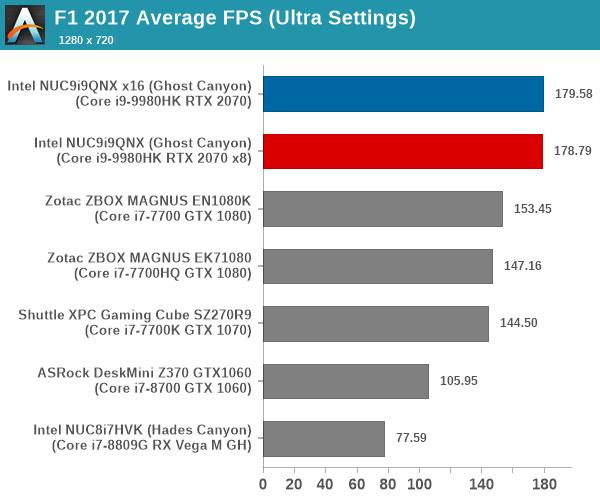
The supplied example benchmark (with some minor tweaks) is processed at four different resolutions while maintaining the graphics settings at the built-in 'Ultra' level.
Grand Theft Auto V
GTA doesn’t provide graphical presets, but opens up the options to users and extends the boundaries by pushing even the hardest systems to the limit using Rockstar’s Advanced Game Engine under DirectX 11. Whether the user is flying high in the mountains with long draw distances or dealing with assorted trash in the city, when cranked up to maximum it creates stunning visuals but hard work for both the CPU and the GPU. For our test we have scripted a version of the in-game benchmark. The in-game benchmark consists of five scenarios: four short panning shots with varying lighting and weather effects, and a fifth action sequence that lasts around 90 seconds. We use only the final part of the benchmark, which combines a flight scene in a jet followed by an inner city drive-by through several intersections followed by ramming a tanker that explodes, causing other cars to explode as well. This is a mix of distance rendering followed by a detailed near-rendering action sequence.
| Grand Theft Auto V Performance | |||
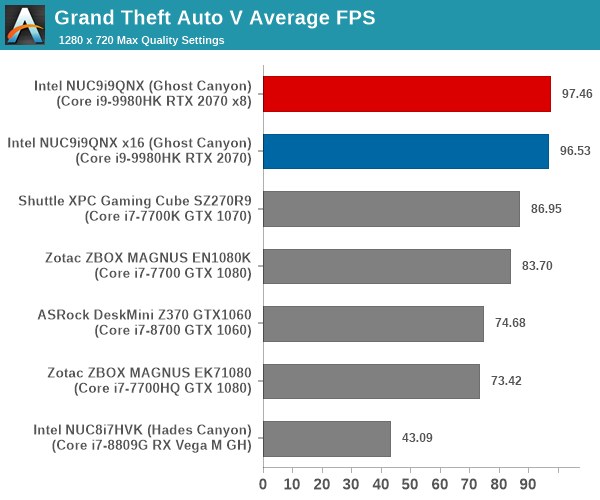
We processed the benchmark across various resolutions and quality settings (detailed here). The results are presented above.
Middle Earth: Shadow of War
Middle Earth: Shadow of War is an action RPG. In our previous gaming benchmarks suite, we used its prequel - Shadow of Mordor. Produced by Monolith and using the new LithTech Firebird engine and numerous detail add-ons, Shadow of War goes for detail and complexity. The graphics settings include standard options such as Graphical Quality, Lighting, Mesh, Motion Blur, Shadow Quality, Textures, Vegetation Range, Depth of Field, Transparency and Tessellation. There are standard presets as well. The game also includes a 'Dynamic Resolution' option that automatically alters graphics quality to hit a pre-set frame rate. We benchmarked the game at four different resolutions - 4K, 1440p, 1080p, and 720p. Two standard presets - Ultra and Medium - were used at each resolution after turning off the dynamic resolution option.
| Middle Earth: Shadow of War Performance | |||

While the Ghost Canyon NUC is the best of the lot, the interesting aspect to observe here is that x8 or x16 essentially makes no difference to the game's performance.
Far Cry 5
Ubisoft's Far Cry 5 is an action-adventure first-person shooter game released in March 2018. The game comes with an in-built benchmark and has standard pre-sets for quality settings. We benchmarked the game at four different resolutions - 720p, 1080p, 1440p, and 2160p. Two preset quality settings were processed at each resolution - normal and ultra.
| Far Cry 5 Performance | |||
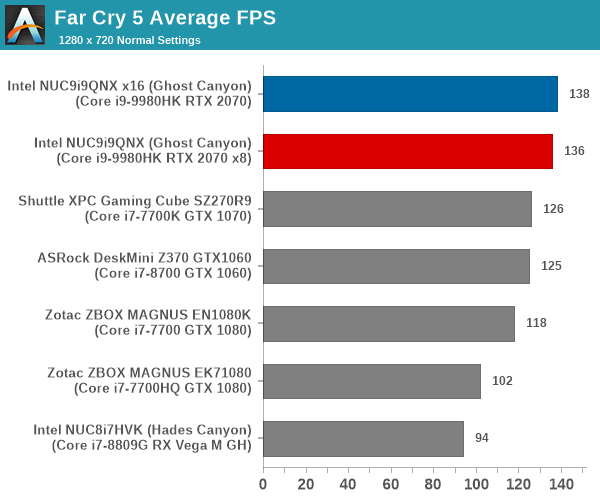
As expected, the Ghost Canyon NUC configuration performs much better than any of the other configurations in the list. The x16 mode delivers slightly more FPS compared to the x8 mode across all tested resolutions and quality settings, unlike what we saw in the Shadow of War gaming workload.
Overall, the NUC9i9QNX combined with the ASUS RTX 2070 Mini manages to deliver more gaming performance than any other SFF PC we have seen so far - even managing to surpass larger systems in the process.










109 Comments
View All Comments
PeachNCream - Thursday, April 16, 2020 - link
NUCs have usually had a bit of a markup, but the price here is quite a bit higher than one would expect.Deicidium369 - Thursday, April 16, 2020 - link
I don't consider this a NUC, even though Intel puts it in that category - same thing with the ones with the skulls on them... the standard 4.5"x4.5" are the only ones I consider a NUC. Not really sure what the use case for this machine is.PeachNCream - Friday, April 17, 2020 - link
I agree with you all around. This is far different than the goals Intel originally set out to attain with the NUC form factor. It's Intel's objective and the company can do whatever it wants with the name, slapping it on a super computer for all I care, but that doesn't mean we are compelled to acknowledge it in the same way we would prior designs.The use case for it - a small form factor system used for gaming or GPU-based graphics work is certainly the intent. The problem is the pricing is way off as a lot of others have pointed out so the same goals could be accomplished in a similar, but slightly larger system for considerably lower cost.
This seems like a Google-style thought experiment that some employee or team dreamed up. it got approved and is on sale. If subsequent generations are not sold in the future, we will know it didn't get close to projections or targets.
Deicidium369 - Friday, April 17, 2020 - link
I have over 60 of these deployed in my business offices. I fabricate a 4.5" x ~11" piece of stainless steel - each end is drilled with the 100mm VESA bolt pattern. There are 2 90deg brakes (bends). 1 end in sandwiched between the monitor stand and monitor - other side the NUC mounting bracket is bolted. Short (12") DP and USB cables connect NUC to monitor - sourced a 100W power brick (Intel ships a variety of designs. some with convex sides) that is rectangular - with a standard 3pin AC jack and a barrel DC jack. Y splitter for the AC power - 1 to monitor other to power brick, and a 12" DC cable. So, coming up from the wallplate is 1 AC power cable & 1 CAT6e cableMakes an all in 1 - usecase doesn't require a desktop PC - even a normal SFF one. My employees can choose wired or wireless Microsoft keybd/mice. Keeps it super neat and super clean.
When I started to migrate those people to work at home, made the move super easy - and didn't require one of my IT staff to handle the moves - the Palo Alto Networks VPN Endpoint was preconfigured, so just plug in the desktop and the IP Phone, and they were up an running again.
I have 3 generations of units - about half are the oldest - the real NUC Tiger Lake will replace them all (not running into issues with compute power - but the iGPU struggles with dual 2560 or 4K monitors. 32GB + Samsung 512GB or 1TB NVME - no 2.5"
Icehawk - Saturday, April 18, 2020 - link
Take a look at Dell’s 7070 Ultra. It’s basically a monitor stand, combine with a USB-C monitor and it’s very sleek. I work for a mid sized bank and will be deploying these in the future in our branches where before we used mini-PCs VESA mounted. Much cleaner and enterprise pricing is good.Deicidium369 - Saturday, April 18, 2020 - link
Thank's for the information - I actually bought one soon after they were released and evaluated as a replacement for the 35 or so NUCs I had installed at the time. There were manufacturing defects or issues, and had to send the eval unit back twice. By December, I had to purchase machines, as the business was expanding - and just couldn't, at that point, consider the Dell an option. The processing power at the time was pretty well evenly matched - the dual channel memory in the NUCs wasn't a huge advantage in testing. and the NVMe speed was comparable. So from a performance standpoint, they were pretty evenly matched - one of the main big features that was lacking in the Dell was the IGP - I had thought that instead of Comet Lake we would have gotten Ice Lake. Our workflow is pretty mundane - Word Excel Outlook and Chrome... So at this point the big reason for sticking with the NUCs is the "ecosystem" I have built around them - when we do replace with the Tiger Lake NUCs later this year, will be pretty well painless.ingwe - Friday, April 17, 2020 - link
Yeah the pricing is crazy. Which is disappointing because I think it is a pretty neat concept and I would love something like this from AMD.Deicidium369 - Friday, April 17, 2020 - link
AMD sells CPU and GPU - nothing else.Sailor23M - Saturday, April 18, 2020 - link
Agree, Intel has lost it way with the NUCs. They should be in the $500-$999 range, come with best embedded graphics that Intel can provide with lots of ports. Not sure who is excited about $3000 SFF box.Qasar - Saturday, April 18, 2020 - link
intel has lost its way in alot more then just nucs. it lost its way 5-7 years ago when it thought ot was unbeatable, and kept rehashing the same cpu over and over.